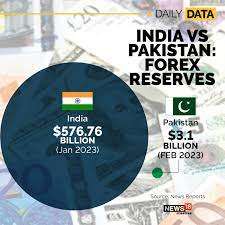How Does the Indian Economy Compare to Pakistan's Economy?

August 25, 2023
India Economy compare to Pakistan Economy with GDP
We can provide you with a general comparison of the Indian and Pakistani economies. However, please note that economic conditions can change over time, and I recommend checking more recent sources for the latest information.
Size of Economy: India has a much larger economy compared to Pakistan. It is one of the world's largest economies in terms of nominal GDP, whereas Pakistan's economy is smaller in comparison.
GDP and Growth Rate: India's GDP has traditionally been significantly larger than Pakistan's. India has experienced higher GDP growth rates on average, driven by its large population, diverse industries, and services sector. Pakistan's growth rates have been lower due to various factors, including political instability and security concerns.
Industries and Sectors: India has a more diversified economy with a strong presence in sectors such as information technology, services, manufacturing, agriculture, and pharmaceuticals. Pakistan's economy has a greater reliance on agriculture and lacks the same level of diversification.
Foreign Investment and Trade: India generally attracts more foreign direct investment (FDI) due to its larger market, skilled workforce, and established industries. Its trade relations are more extensive and diverse compared to Pakistan.
Infrastructure: India has made substantial investments in infrastructure, including transportation, energy, and telecommunications. While Pakistan has also developed its infrastructure, it may face more challenges in terms of development and maintenance.
Social Indicators: Both countries face social challenges, but India generally has a larger and more diverse set of social indicators. Poverty rates, literacy rates, and access to healthcare and education vary between the two countries.
Geo-Political Factors: The political relationship and historical tensions between India and Pakistan have influenced their economic ties. Political stability and regional security play a role in shaping economic conditions in both countries.
It's important to note that economic comparisons can be complex and multifaceted, influenced by a wide range of factors including historical context, political decisions, global economic trends, and more. For the most up-to-date and accurate information, it's recommended to refer to recent reports from reliable sources like the World Bank, International Monetary Fund (IMF), and national economic agencies of India and Pakistan.
Top 10 Facts About the Indian Economy and Pakistan Economy
Indian Economy:
-
Large Economy: India is one of the world's largest economies by nominal GDP, ranking among the top economies globally.
-
Services Dominance: The services sector is a major contributor to India's GDP, with information technology, business process outsourcing, and other services playing a significant role.
-
Manufacturing: India has a diverse manufacturing sector, ranging from automotive to pharmaceuticals, although it's less dominant than the services sector.
-
Population: India has one of the world's largest populations, which both contributes to its market potential and presents challenges for development.
-
Foreign Direct Investment: India attracts substantial foreign direct investment, particularly in technology and e-commerce sectors.
-
Agriculture: Agriculture is a significant sector, employing a large portion of the population, although its contribution to GDP has been decreasing.
-
Infrastructure Development: India has been investing in infrastructure projects, including transportation, renewable energy, and smart cities.
-
Trade: India has diverse trade partners and is known for its information technology and pharmaceutical exports.
-
Youth Demographic: India has a young population, which can be a demographic dividend if effectively harnessed for economic growth.
-
Economic Challenges: India faces challenges such as income inequality, poverty, and disparities in development across states.
Pakistan Economy:
-
Medium-sized Economy: Pakistan's economy is smaller than India's in terms of nominal GDP, but it's still a significant economy in the region.
-
Agriculture-Centric: Agriculture plays a crucial role in Pakistan's economy, employing a large portion of the workforce.
-
Textile Industry: The textile sector is a major contributor to Pakistan's exports and industrial output.
-
Foreign Exchange Challenges: Pakistan has faced balance of payments issues and has sought assistance from international financial institutions.
-
Security Concerns: Security challenges have affected Pakistan's economy, including foreign investment and trade.
-
Services and Remittances: The services sector, particularly remittances from overseas Pakistanis, is important for the economy.
-
Energy Shortages: Pakistan has struggled with energy shortages that impact industrial productivity.
-
China-Pakistan Economic Corridor: This initiative involves major infrastructure and development projects, aiming to improve connectivity and economic growth.
-
Informal Economy: A significant portion of Pakistan's economy operates in the informal sector.
-
Economic Reforms: Pakistan has been working on economic reforms to address fiscal deficits and attract investment.
Remember that economic conditions can change rapidly, so it's advisable to consult recent reports and data from reliable sources for the latest information on the Indian and Pakistani economies

